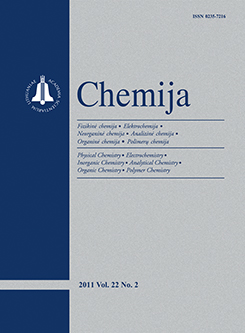 ISSN 0235-7216 ISSN 2424-4538 (online) |
2007 m. Nr. 1 Electrochemical investigations of Ni–P electroless
deposition in solutions containing amino acetic acid
The complexity of the anodic process taking place during electroless nickel plating in a solution containing hypophosphite as a reducing agent and amino acetic acid as a ligand has been verified by the results of electrochemical investigations. In the case of low nickel deposition rate, vNi–P, c.a. 2–4 μm·h–1, an electrochemical reaction played the main role in the autocatalytic process. With an increase in the intensity of the plating process, the difference between vNi–P and the maximal anodic current intensity ia increased due to the difficulties in estimating the ia value (coupled cathodic Ni deposition reaction has a retarding effect on the anodic process) as well as due to the participation of chemical reactions in the catalytic process. Voltammetric measurements carried out at potentials more positive than the mixed potential showed the increase in Ni–P electrode activity with an increase in anodic polarization. Keywords: Ni–P deposition, hypophosphite, anodic oxidation, voltammograms, surface activation |
Issues:
2017 - Vol.28 No. 1, No. 2, No. 3, No. 4 2016 - Vol.27 No. 1, No. 2, No. 3, No. 4 2015 - Vol.26 No. 1, No. 2, No. 3, No. 4 2014 - Vol.25 No. 1, No. 2, No. 3, No. 4 2013 - Vol.24 No. 1, No. 2, No. 3, No. 4 2012 - Vol.23 No. 1, No. 2, No. 3, No. 4 2011 - Vol.22 No. 1, No. 2, No. 3, No. 4 2010 - Vol.21 No. 1, No. 2-4 2009 - Vol.20 No. 1, No. 2, No. 3, No. 4 2008 - Vol.19 No. 1, No. 2, No. 3-4 2007 - Vol.18 No. 1, No. 2, No. 3, No. 4 2006 - Vol.17 No. 1, No. 2-3, No. 4 2005 - Vol.16 No. 1, No. 2, No. 3-4 2004 - Vol.15 No. 1, No. 2, No. 3, No. 4 2003 - Vol.14 No. 1, No. 2, No. 3, No. 4 2002 - Vol.13 No. 1, No. 2, No. 3, No. 4 2001 - Vol.12 No. 1, No. 2, No. 3, No. 4 |